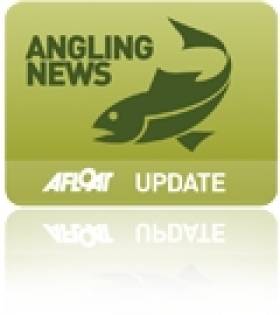Displaying items by tag: Lough Melvin
Dog Deaths Prompt Warnings to Avoid Numerous Northern Ireland Waters Over Toxic Blue-Green Algae
Three councils in Northern Ireland have issues warnings over the presence of toxic blue-green algae in their local waterways, as BelfastLive reports.
Fermanagh and Omagh District Council is warning people away from the water at Lough Melvin after an alarming six dogs died following visits to the area in recent days.
Another dog died after contact with the shore of Lough Neagh, where Antrim and Newtownabbey Borough Council confirmed the presence of the algae.
And Mid Ulster District Council has also identified blue-green algae in the waters of Ballyronan Marina and Battery Harbour.
The bacteria that comprise blue-green algae produce toxins that are harmful to humans and even more so to animals when ingested, inhaled or they make contact with the skin.
BelfastLive has more on the story HERE.
Picturesque Homes In Clare & Fermanagh Perfect For Anglers
#WaterfrontProperty - Two new properties on the market in Clare and Fermanagh are sure to appeal to keen anglers.
Sugarloaf on Clifden Hill in Co Clare overlooks Lake Inchiquin, described by the Irish Independent as an 'angler's paradise', and hosting a bounty of wildlife including the spectacular sea eagle.
But the picturesque spot is also a popular area for sunny-day picnics, and not only with the locals.
Sugarloaf provides a permanent picnic spot in the heart of that beautiful visa, with a detached three-bed home in 1.5 acres of gardens with panoramic views of the lake nearby and the Burren beyond.
And in spite of its privacy, with no neighbours in sight, you're just 3.5km from the village of Corofin and a swift drive further on to Ennis.
The Irish Independent has more on this property, on the market for €315,000.
North of the border, angling enthusiasts might be tempted by Amled's Fishing Lodge in Garrison, Co Fermanagh.
Within walking distance of Lough Melvin, the spacious detached five-bed home is on a secure site with high fencing, and plenty of room for boats and more in the driveway.
The wooded grounds have also been developed by the previous owner for wheelchair use, making garden maintenance easier than usual.
It's an unfinished renovation project - the upstairs is yet to be completed - but it'll be more than worth the effort to many, especially with an asking price of just £115,000 (€159,000). 4NI has more on this property.
Elsewhere, for those who just want to enjoy that seaside vibe, the Irish Independent sings the praises of Salthill in Galway.
Just a short walk from the centre of the City of the Tribes, the charming suburb maintains its own old-school seaside town atmosphere, with plenty of local social options, especially for dining.
And of course there's the renowned promenade, which hosts among others the annual An Tóstal race for Galway Hookers.
Lough Melvin Crowns Four-Time Open Trout Champ
#Angling - In Friday's Irish Times, Derek Evans reports from the Lough Melvin Open Trout Angling Championship last weekend, where Brian Uprichard took the title for the second year in a row, and the fourth time in total.
The Co Down angler teamed with fellow former champion Cecil Marshall from Sligo to qualify for the final with a four-fish haul, then seal the championship with "five good fish" - topping a field of nearly 300 anglers from throughout Ireland and beyond.
"On this my first visit to Garrison and Lough Melvin, I was taken aback by the warm welcome I received and the camaraderie among anglers both on and off the water," writes Evans. "The new clubhouse, officially opened earlier this year, meets all present-day requirements and is testimony to a hard-working committee."
As reported earlier this year on Afloat.ie, the Fermanagh lake has been bucking the trend of declining fish stocks in Northern Ireland's inland waterways, with a salmon surplus that can only add to the sport.
Elsewhere, Carrickmacross anglers had reason to celebrate at the recent NCFFI All-Ireland Angling Championships in Cavan.
As the Dundalk Democrat reports, members of the Carrickmacross Coarse Angling and Junior Development Club placed first and third in the senior competition of the junior angling event.
Jamie Edwards landed an impressive 9.9kg for his number-one spot while clubmate Lee Harris landed 7.12kg.
And in the women's competition, Carrick's Emma McMahon topped the scales with her catch.
Salmon Surplus Sure to Attract Anglers to Lough Melvin
#Angling - Anglers on both sides of the border will be looking forward to a salmon bonanza on Lough Melvin when it opens for fishing on Friday 1 February, according to the Impartial Reporter.
The Fermanagh lake has been bucking the trend of declining fish stocks in Northern Ireland's inland waterways, which have prompted concerns that the species has been reduced to 'dodo levels'.
Despite the news last October that just three out of every 100 wild salmon returned to Northern Ireland's rivers in 2011, fishery experts believe that Lough Melvin and the River Downes that connects it to the sea have a surplus of salmon - providing valuable sport (and dinner) for angling locals and tourists alike.
Even so, anglers in both jurisdictions of the border-straddling fishery will have to abide by their respective legislation, which provides for a strict tagging and recording system.
On the Northern Ireland side, anglers are issued one tag at a time up to a total of three for the first three months of the season, with a maximum of 10 issued for any single angler on Lough Melvin by the close of fishing on 30 September.
The Impartial Reporter has much more on the story HERE.
































































